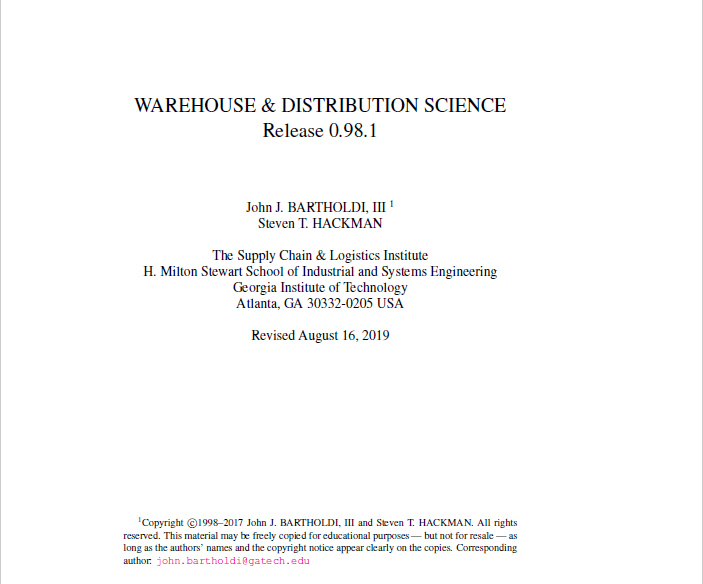WAREHOUSE&DISTRIBUTION SCIENCE
 本书的主题是仓库布局和作业的科学。我们之所以称之为“科学”,是因为我们为此建立了数学和计算机模型。当前太多的仓储实践都是基于经验法则和简单的比率。就目前而言,这很好。但是还有更多的事情可以做。大多数仓库都有详细的记录,准确记录每个客户的订单详情和时间。通常,该数据由IT部门作为财务报告的一部分来提供;但是这些数据可以在作业上对仓库布局和操作进行“调整”为适应客户订单的最佳模式。本书将向您展示如何做到这点。
本书的主题是仓库布局和作业的科学。我们之所以称之为“科学”,是因为我们为此建立了数学和计算机模型。当前太多的仓储实践都是基于经验法则和简单的比率。就目前而言,这很好。但是还有更多的事情可以做。大多数仓库都有详细的记录,准确记录每个客户的订单详情和时间。通常,该数据由IT部门作为财务报告的一部分来提供;但是这些数据可以在作业上对仓库布局和操作进行“调整”为适应客户订单的最佳模式。本书将向您展示如何做到这点。
还有其他有关仓储的书籍,但它们大多只限于列出设备类型,拣选方法等。这是必要的,也做的很好。但是这里的重点不是分类法,而是关于优化仓库作业的方法论。
本书在另一方面也与众不同:我们试图避免昂贵且缺乏灵活性的整体式优化模型。相反,我们采用强调决策权下放的方法。例如,在仓库中分配空间时,我们将要求每个SKU制定一份“业务计划”,其中详细说明了其所占用空间和对等将产生的经济利益;然后我们将根据最佳回报对SKU进行排名。商业计划很可能是数学模型,但是分配过程只是从排序列表中完成,这种方法使用起来非常简单。实际上,人们可以动态地做出决策,将空间重新分配给当前的最佳产出者。诀窍是价值匹配。最终,可以看到托盘、箱子、单件等商品都可能像通勤者一样穿过配送中心,每个人都知道商品的尺寸和特殊处理要求。他们可能会与周围的环境进行互动,以了解例如每种存储类型的可用空间和人工劳效,然后就如何逐步执行所需的流程并继续向客户做出决策。随着RFID的不断普及,在每个项目上都增加了存储能力和计算能力,这种分散程度是可以想象的。然后就如何进行必要的流程并继续向客户做出决策。
权力下放的另一个例子是我们将“蚂蚁拣货法”作为一种新的订单拣选方式,其中工作由工人的独立运动重新分配。如果”蚂蚁队伍“配置正确,则订单将 平衡他们之间的工作,从而消除瓶颈。而且,这是自发发生的,没有工人的意图或意识。这意味着,与精心设计的工程师或经理计划的相比,订单拣选会更加有效。
该书在某种程度上反映了北美地区分销的挑战,那里的劳动力成本相对较高,资本成本相对较低,而且数量很大。但是,我们构建的所有工具和模型也可以在其他环境中使用,即使它们的重点是最小化人工成本。该模型将确定空间交换所用的“交换率”(劳动力);因此,即使在劳动力成本较低的地区,任何人都可以执行优化,澄清时间交换,然后根据自己的情况做出明智的工程决策。
【备注】大董知识库计划先按章节将内容整理到本论坛 中,目的是为了能够方便大家一起来翻译和添加更新意见,感兴趣的朋友可以关注本文的话题“仓储与配送科学”,以获得持续更新的提醒!
The topic of this book is the science of warehouse layout and operations. We say “science” because we develop mathematical and computer models. Too much of current warehousing practice is based on rules-of-thumb and simplistic ratios. This is fine as far as it goes; but there is much more that can be done. Most warehouses have elaborate records of exactly what every customer ordered and when. Typically this information is generated by the IT department as part of financial reporting; but this information can be used by operations to “tune” the warehouse layout and operations to the patterns of customer orders. This book shows you how to do this.
There are other books on warehousing but they mostly confine themselves to listing types of equipment, types of order-picking, and so on. This is necessary and good; but the emphasis here is not on taxonomy but on developing methodology to optimize warehouse operations.
This book is distinctive in another way as well: We try to avoid monolithic optimization models, which are expensive and inflexible. Instead we adopt an approach that emphasizes decentralizing decisions. For example, in allocating space in a warehouse, we will require each stockkeeping unit to make a “business plan” that details the economic benefits it will generate in return for space; then we will rank the SKUs according to which offers the best return. The business plan may well be a mathematical model; but the process of allocation is done simply from a sorted list. Such an approach offers great simplicity of use; indeed, one can make decisions dynamically, re-allocating space to the current best bidder of the moment. The trick is in pricing out the bids appropriately. Ultimately, this leads to a view of the pallets, cartons, pieces of product moving through the distribution center as commuters might, with each one aware of its dimensions and requirements for special handling. They might enter into negotiations with their environment to learn, for example, the available space and labor economics of each type of storage, and then make their decisions about how to move through the required processes and on to the customer. This degree of decentralization is imaginable as RFID continues to spread, placing memory and, increasingly, computing power on each item.
Another example of decentralization is our treatment of “bucket brigades” as a new style of order-picking in which the work is reallocated by the independent movements of the workers. If the bucket brigade is configured properly, the order-pickers will balance the work amongst themselves and so eliminate bottlenecks. Moreover, this happens spontaneously, without intention or awareness of the workers. This means that the order-picking can be more effective than if planned by a careful engineer or manager.
To some extent the book reflects the challenges of distribution in North America, where there are relatively high labor costs, relatively low capital costs, and high volumes. However, all the tools and models we build can be used in other environments as well, even when their emphasis is on minimizing labor costs. The model will determine the “exchange rate” by which space can be exchanged for time (labor); and so anyone, even in a low labor cost region, can perform the optimization, clarify the exchange of space for time, and then make informed engineering decisions that are appropriate to his or her context.
This guy is lazy,Introduction has not been set